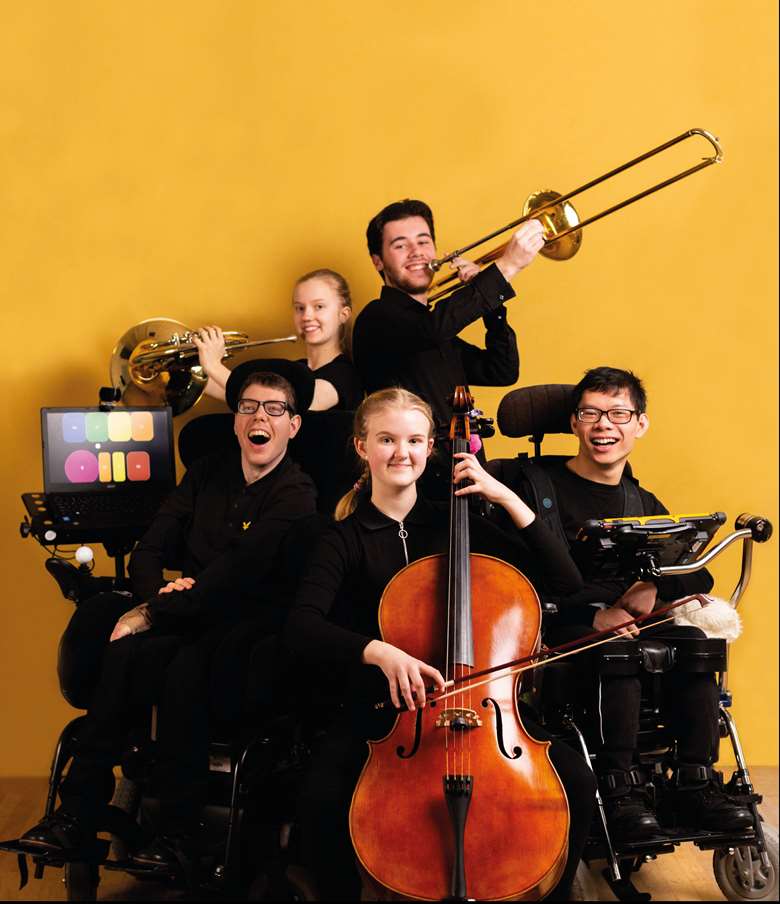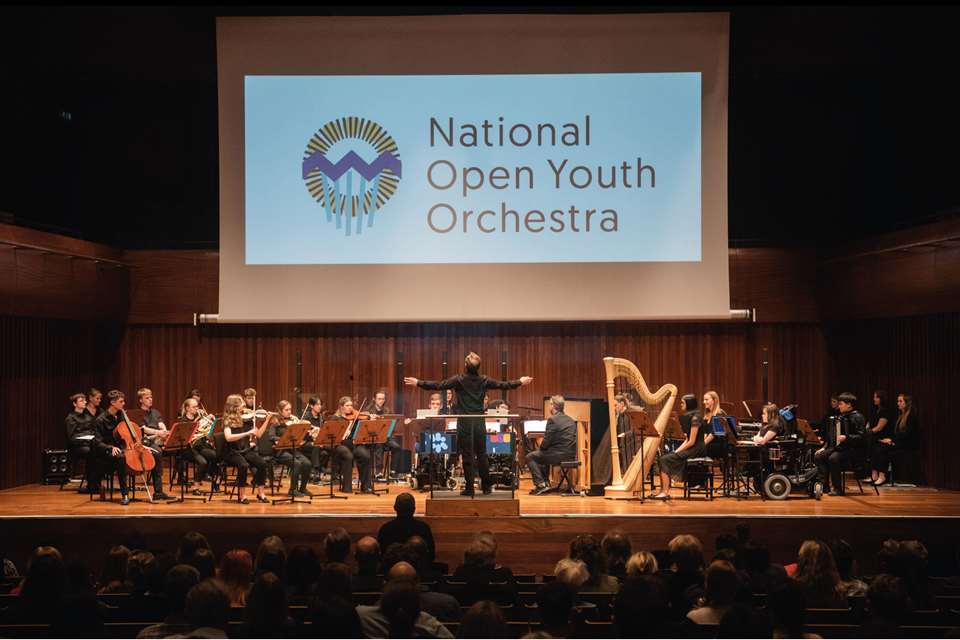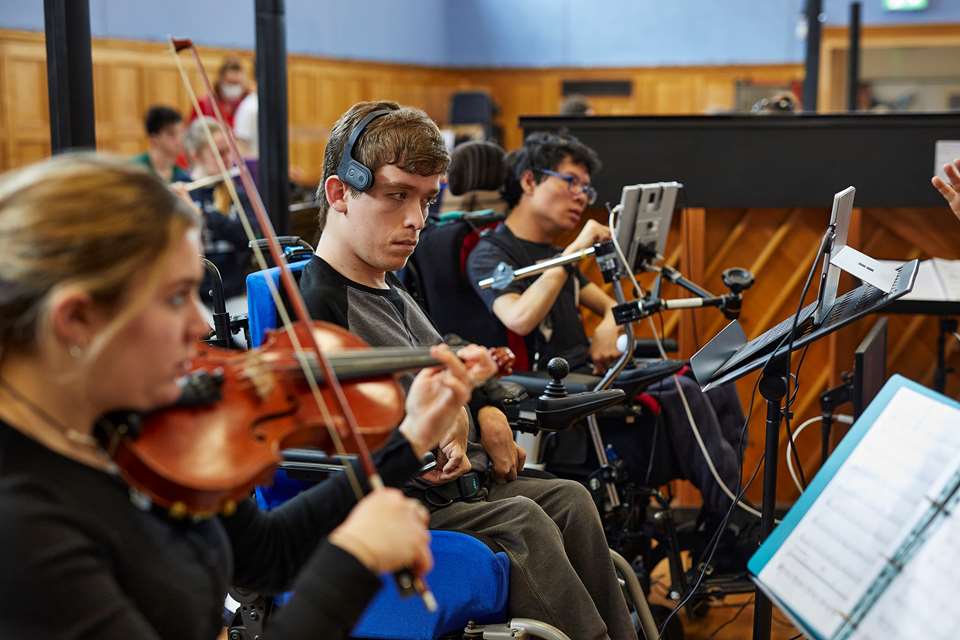National Open Youth Orchestra: key findings
Hattie Fisk
Thursday, June 1, 2023
With an eye to encourage more diverse and inclusive orchestras, Hattie Fisk takes a look at the findings of NOYO’s recent report and investigates what advice there is for music educators.

Courtesy NOYO
‘Everyone who has heard or experienced music would agree that it should be available to everyone, but there’s a long way to go to actually make that happen. We challenge you to think about how you can bring things from the report into your practice.’ This call-out to music educators from the young disabled and non-disabled musicians of the National Open Youth Orchestra (NOYO) prefaces a major report, released in partnership with Sound Connections, which shares learnings from this pioneering inclusive orchestra’s journey between 2018 and 2022.
The orchestra
NOYO is the world’s first disabled-led national youth orchestra. Started in 2018, it delivers across four, soon to be five, locations across the UK. The charity aligns its work with the social model of disability, which highlights how barriers created by society disable people. Currently, there are 38 musicians in NOYO across the four locations, of whom about 80% identify as disabled.
On the report, artistic director Doug Bott says: ‘this report is about sharing more widely what we’ve been trying for four years. We’re not looking to clone the National Open Youth Orchestra. We’re looking for people to cherry pick what works for them and to take that on, whether that’s in a musical context, a dance context, or any other kind of context.’
The key findings:
1. You can successfully combine inclusion with high musical expectations
NOYO works to ensure any aspect of the orchestra is accessible to all musicians. Musicians’ access requirements and wellbeing are always prioritised, alongside their musical progress. However, there is no compromise on high standards and expectations musically. As a result, musicians develop a breadth of skills. For some, performing in NOYO concerts ignited a passion and enthusiasm for playing professionally.
Oliver Cross, who played harmonicas and bass synth with NOYO until last year, is now a professional musician. ‘[NOYO] values musicians’ strengths rather than focusing on their disability and considers how to fit the orchestra to the musician, rather than the musician to the orchestra,’ he says. ‘Everything is customised to the individual musician to make music as accessible as possible. The access is there in NOYO to make sure that each musician can perform to the best of their ability. Access does not mean making things easier musically.’
2. Being more musician-centred can unlock the creative power of diversity
NOYO has taken responsibility for creating an inclusive environment, capturing musicians’ needs from the outset so they don’t have to advocate for themselves. Moving from feelings of inclusion to belonging to a community has been important for NOYO musicians to thrive musically. They also have a say in the programming and playing of music, which has led to a greater sense of ownership, as well as generating exciting, dynamic repertoire.
3. Diversity and inclusion can fuel the creation of exciting new music
The NOYO sound results from the effective integration of a diverse group of musicians, combined with a pioneering use of electronic and ‘non-traditional’ acoustic instruments. NOYO has attracted cutting-edge composers, commissioning adaptable music with non-instrument-specific parts, inviting experimentation while also giving young musicians a say. Musicians reported that, due to this, NOYO was more interesting and exciting than a standard orchestra.
4. We’ve got to learn from each other and fast track inclusion
There continues to be a lack of clear progression pathways for young disabled musicians, and not enough opportunities to progress beyond NOYO. Music leaders at NOYO have developed skills, confidence, knowledge and understanding, as well as a new pedagogy around instruments such as the Clarion. However, within the wider music education sector, training opportunities to work in an inclusive context remain limited.
Abigail D’Amore, an independent music education consultant and report co-author on behalf of Sound Connections, said: ‘Generally in the music education sector, we lack a workforce that is skilled and confident, knowledgeable and has the right sort of attributes to be able to work in an inclusive setting like NOYO. This is a genuine issue. Many teachers I come across don’t fully understand the social model of disability, and don’t have the attitude needed to work in this musician-centred way. Some of the most fantastic music leaders tend to be working in more community-based settings, but across mainstream schools and music education hubs, there is a lot of work that needs doing.’
5. Radical empathy is critical for change
The NOYO experience shows that change among other musicians, music leaders, composers and audience members has come from them actively considering the perspectives of disabled musicians, and questioning their perceptions of what an orchestra could and should be. D’Amore says that one of the most interesting changes seen in the report was the attitude towards the concerts and the music video ‘What Fear We then?’ from 2022, and the increasing amount of ‘radical empathy’ that can be seen. ‘[Audience members and musicians] moved from a place of empathy – so demonstrating an understanding and awareness of some of the barriers disabled musicians are facing, to a point of actually wanting to change their own attitudes,’ she says. ‘There was no sense that the non-disabled musicians on stage were there to bolster the disabled musicians in the group.’
6. Audience development
NOYO’s last key-finding uncovered the benefits of a relaxed environment for some concert-goers, highlighting how bringing diversity and inclusion into the concert hall can unlock a significant opportunity for audience development.
Recommendations from NOYO musicians:
-
If you lead an ensemble or orchestra, offer support on a personal as well as musical level: talk to members on a one-to-one basis to create a friendly, caring relationship with them. Some disabled musicians might be fine with the musical side but struggle socially. Help them if you spot this. Offer a quiet space for people who need a break.
-
Send out a plan of the rehearsal two weeks in advance with the pieces, breaks and timing. This means all musicians know what’s required of them and can give their best contribution. Don’t be afraid to ask disabled students what adjustments they might need, and don’t try to guess, as everyone is different.
-
Don’t force a student to learn to read sheet-music. This can be extremely challenging for some disabled people, and put them off music altogether. Every NOYO musician receives tailored scores and they also use audio tracks.
NOYO musicians have set out a series of questions to engage music educators, and prompt them to become part of the change. Read the questions and the full NOYO report at noyo.org.uk/report




